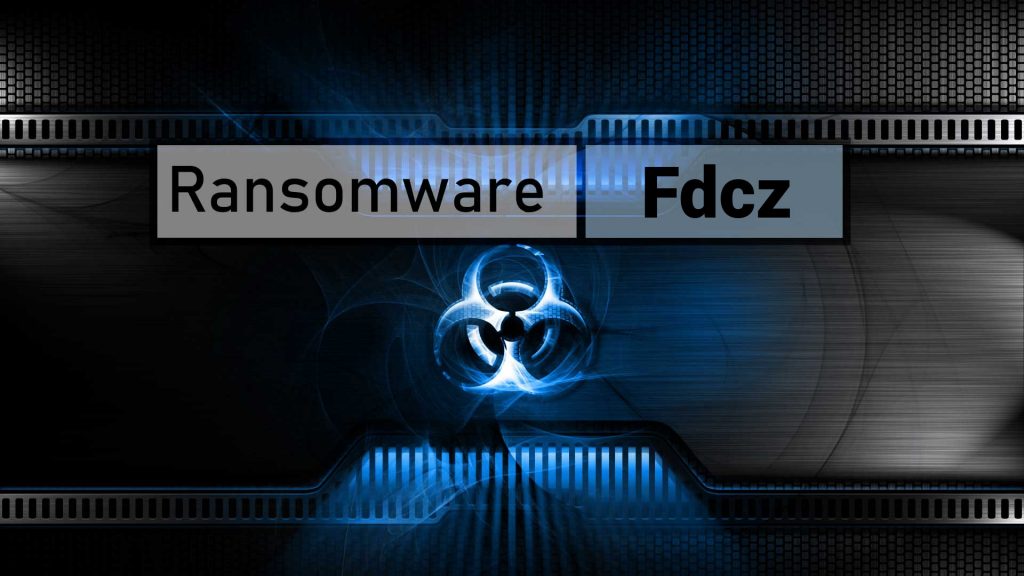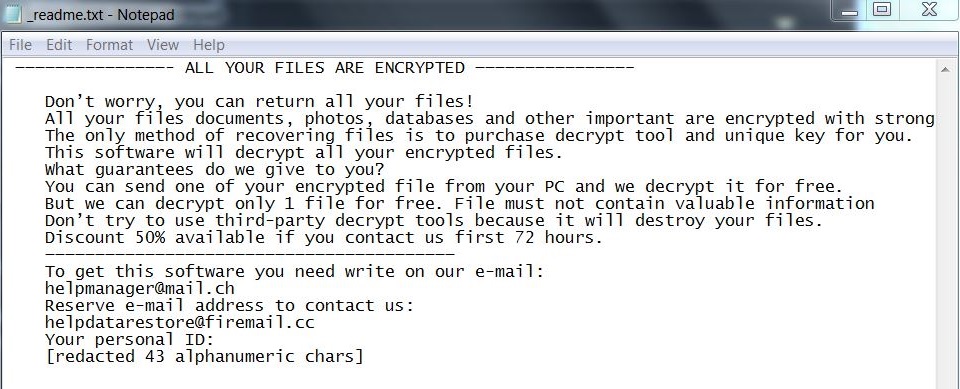Remove FDCZ ransomware And Restore Infected Files
FDCZ ransomware: Complete Delete Process
FDCZ ransomware is malicious software that attacks computers, encrypts data and shows messages asking victims to pay a ransom in order to access those files again. Coming from the family of STOP Ransomware, it can contaminate almost all types of data including audios, videos, documents, presentations, spreadsheets etc. This hazardous crypto-malware uses a sophisticated encryption algorithm to lock the targeted data and also marks them with “.fdcz” extension. Similar to Onim Ransomware and other file-encrypting viruses, it has also been found mainly compromising Windows based PC systems and can infect all versions of Windows including the most recent one Win 10.

Data Encryption Followed By Ransom Demanding:
Once the encryption process is completed, FDCZ ransomware shows a ransom note named “_readme.txt” and informs victims about the unkind situation. They are also instructed that the only way to regain access to those files is by purchasing the decryption tool and unique key from the attacker. Users are also offered to decrypt one encrypted file for free that should not contain valuable information. Hackers will decode it and send it back to prove that the decryption is possible. The text file also warns victims not to use third-party tools as it will result in destroy the data. The price of the tool can be halved if they contact the FDCZ ransomware operators within 72 hours via the provided email addresses.
Paying Ransom Doesn’t Guarantee File-recovery:
According to cyber security experts, even if the victimized users make payment, there is no guarantee that cyber crooks will deliver the required decryption software. Instead, they send rogue application in the name of decryption tool which causes even more hazards once installed. We highly advise to not make any sort of payment to the attackers as it will possibly lead to both files as well as money loss. Threat actors have malicious purpose and hence, you should not trust them under any circumstance, instead, you should focus on FDCZ ransomware removal from computer.
Recover Data Via Backup:
If you create a system backup, you can try to restore the data using the Windows backup. In the way, the files can be recovered even in the worst scenarios. And hence, setting up Automatic Windows Backup is a great way to avoid data loss. For this, you have to:
- first go to Control panel
- then press “System and Security”
- now click “Backup and Restore”
- then click Restore files from backup.
Click the “Restore my files” option in the Backup and Restore screen and follow the wizard to retrieve the data. If this option is not available, then you can also restore the files encrypted by FDCZ ransomware using the backup, created before the attack and saved on any external location. However, even if you don’t have a proper backup on any external drive, then you can try a professional data-recovery application which you can download at this very place via the link provided under this article.

Distribution Of FDCZ ransomware:
Most of the file-encrypting viruses are spread as attachments from spammed emails. However, they can be also dropped by exploit kits onto the vulnerable devices or downloaded from malicious sites through malvertisements and so on. The deceptive emails are sent by cyber crooks in thousands that are disguised as ‘important’ or ‘crucial’. However, they usually contain malicious files which once executed, lead to the penetration of FDCZ ransomware or other crypto-viruses.
And hence, it is advisable to ignore suspicious emails that you receive from unknown addresses. You should first scan the attachment of suspicious emails using a reputable anti-malware tool before opening it. The virulent files can be in various formats such as PDF or Ms Office documents, executable files, achieve files and so on. So, be careful when an email is delivered into your inbox that was not expected to get. In case your PC is already infected with this crypto-virus, you must remove FDCZ ransomware from the device as soon as possible.
Special Offer (For Windows)
FDCZ ransomware can be creepy computer infection that may regain its presence again and again as it keeps its files hidden on computers. To accomplish a hassle free removal of this malware, we suggest you take a try with a powerful Spyhunter antimalware scanner to check if the program can help you getting rid of this virus.
Do make sure to read SpyHunter’s EULA, Threat Assessment Criteria, and Privacy Policy. Spyhunter free scanner downloaded just scans and detect present threats from computers and can remove them as well once, however it requires you to wiat for next 48 hours. If you intend to remove detected therats instantly, then you will have to buy its licenses version that will activate the software fully.
Data Recovery Offer
We Suggest you to choose your lately created backup files in order to restore your encrypted files, however in case if you don’t have any such backups, you can try a data recovery tool to check if you can restore your lost data.
Antimalware Details And User Guide
Step 1: Remove FDCZ ransomware through “Safe Mode with Networking”
Step 2: Delete FDCZ ransomware using “System Restore”
Step 1: Remove FDCZ ransomware through “Safe Mode with Networking”
For Windows XP and Windows 7 users: Boot the PC in “Safe Mode”. Click on “Start” option and continuously press on F8 during the start process until the “Windows Advanced Option” menu appears on the screen. Choose “Safe Mode with Networking” from the list.

Now, a windows homescreen appears on the desktop and work-station is now working on “Safe mode with networking”.
For Windows 8 Users: Go to the “Start Screen”. In the search results select settings, type “Advanced”. In the “General PC Settings” option, choose “Advanced startup” option. Again, click on the “Restart Now” option. The work-station boots to “Advanced Startup Option Menu”. Press on “Troubleshoot” and then “Advanced options” button. In the “Advanced Option Screen”, press on “Startup Settings”. Again, click on “Restart” button. The work-station will now restart in to the “Startup Setting” screen. Next is to press F5 to boot in Safe Mode in Networking.

For Windows 10 Users: Press on Windows logo and on the “Power” icon. In the newly opened menu, choose “Restart” while continuously holding “Shift” button on the keyboard. In the new open “Choose an option” window, click on “Troubleshoot” and then on the “Advanced Options”. Select “Startup Settings” and press on “Restart”. In the next window, click on “F5” button on the key-board.

Step 2: Delete FDCZ ransomware using “System Restore”
Log-in to the account infected with FDCZ ransomware. Open the browser and download a legitimate anti-malware tool. Do a full System scanning. Remove all the malicious detected entries.
Special Offer (For Windows)
FDCZ ransomware can be creepy computer infection that may regain its presence again and again as it keeps its files hidden on computers. To accomplish a hassle free removal of this malware, we suggest you take a try with a powerful Spyhunter antimalware scanner to check if the program can help you getting rid of this virus.
Do make sure to read SpyHunter’s EULA, Threat Assessment Criteria, and Privacy Policy. Spyhunter free scanner downloaded just scans and detect present threats from computers and can remove them as well once, however it requires you to wiat for next 48 hours. If you intend to remove detected therats instantly, then you will have to buy its licenses version that will activate the software fully.
Data Recovery Offer
We Suggest you to choose your lately created backup files in order to restore your encrypted files, however in case if you don’t have any such backups, you can try a data recovery tool to check if you can restore your lost data.
In case if you cannot start the PC in “Safe Mode with Networking”, Try using “System Restore”
- During the “Startup”, continuously press on F8 key until the “Advanced Option” menu appears. From the list, choose “Safe Mode with Command Prompt” and then press “Enter”

- In the new opened command prompt, enter “cd restore” and then press “Enter”.

- Type: rstrui.exe and Press “ENTER”

- Click “Next” on the new windows

- Choose any of the “Restore Points” and click on “Next”. (This step will restore the work-station to its earlier time and date prior to FDCZ ransomware infiltration in the PC.

- In the newly opened windows, press on “Yes”.

Once your PC gets restored to its previous date and time, download the recommended anti-malware tool and perform a deep scanning in order to remove FDCZ ransomware files if they left in the work-station.
In order to restore the each (separate) file by this ransomware, use “Windows Previous Version” feature. This method is effective when “System Restore Function” is enabled in the work-station.
Important Note: Some variants of FDCZ ransomware delete the “Shadow Volume Copies” as well hence this feature may not work all the time and is applicable for selective computers only.
How to Restore Individual Encrypted File:
In order to restore a single file, right click on it and go to “Properties”. Select “Previous Version” tab. Select a “Restore Point” and click on “Restore” option.

In order to access the files encrypted by FDCZ ransomware, you can also try using “Shadow Explorer”. In order to get more information on this application, press here.

Important: Data Encryption Ransomware are highly dangerous and it is always better that you take precautions to avoid its attack on your work-station. It is advised to use a powerful anti-malware tool in order to get protection in real-time. With this help of “SpyHunter”, “group policy objects” are implanted in the registries in order to block harmful infections like FDCZ ransomware.
Also, In Windows 10, you get a very unique feature called “Fall Creators Update” that offer “Controlled Folder Access” feature in order to block any kind of encryption to the files. With the help of this feature, any files stored in the locations such as “Documents”, “Pictures”, “Music”, “Videos”, “Favorites” and “Desktop” folders are safe by default.

It is very important that you install this “Windows 10 Fall Creators Update” in your PC to protect your important files and data from ransomware encryption. The more information on how to get this update and add an additional protection form rnasomware attack has been discussed here.
How to Recover the Files Encrypted by FDCZ ransomware?
Till now, you would have understood that what had happed to your personal files that got encrypted and how you can remove the scripts and payloads associated with FDCZ ransomware in order to protect your personal files that has not been damaged or encrypted until now. In order to retrieve the locked files, the depth information related to “System Restore” and “Shadow Volume Copies” has already been discussed earlier. However, in case if you are still unable to access the encrypted files then you can try using a data recovery tool.
Use of Data Recovery Tool
This step is for all those victims who have already tries all the above mentioned process but didn’t find any solution. Also it is important that you are able to access the PC and can install any software. The data recovery tool works on the basis of System scanning and recovery algorithm. It searches the System partitions in order to locate the original files which were deleted, corrupted or damaged by the malware. Remember that you must not re-install the Windows OS otherwise the “previous” copies will get deleted permanently. You have to clean the work-station at first and remove FDCZ ransomware infection. Leave the locked files as it is and follow the steps mentioned below.
Step1: Download the software in the work-station by clicking on the “Download” button below.
Step2: Execute the installer by clicking on downloaded files.

Step3: A license agreement page appears on the screen. Click on “Accept” to agree with its terms and use. Follow the on-screen instruction as mentioned and click on “Finish” button.

Step4: Once the installation gets completed, the program gets executed automatically. In the newly opened interface, select the file types that you want to recover and click on “Next”.

Step5: You can select the “Drives” on which you want the software to run and execute the recovery process. Next is to click on the “Scan” button.

Step6: Based on drive you select for scanning, the restore process begins. The whole process may take time depending on the volume of the selected drive and number of files. Once the process gets completed, a data explorer appears on the screen with preview of that data that is to be recovered. Select the files that you want to restore.

Step7. Next is to locate the location where you want to saver the recovered files.

Special Offer (For Windows)
FDCZ ransomware can be creepy computer infection that may regain its presence again and again as it keeps its files hidden on computers. To accomplish a hassle free removal of this malware, we suggest you take a try with a powerful Spyhunter antimalware scanner to check if the program can help you getting rid of this virus.
Do make sure to read SpyHunter’s EULA, Threat Assessment Criteria, and Privacy Policy. Spyhunter free scanner downloaded just scans and detect present threats from computers and can remove them as well once, however it requires you to wiat for next 48 hours. If you intend to remove detected therats instantly, then you will have to buy its licenses version that will activate the software fully.
Data Recovery Offer
We Suggest you to choose your lately created backup files in order to restore your encrypted files, however in case if you don’t have any such backups, you can try a data recovery tool to check if you can restore your lost data.





